The document presents articles from the International Journal of Computer Networks & Communications, emphasizing advancements in healthcare monitoring through mobile device applications and IoT services. Notably, it discusses a real-time wireless health monitoring system that accurately measures physiological data and sends alerts to healthcare professionals. Additionally, it addresses the challenges of GPS inaccuracy and proposes solutions, alongside development in biometric authentication for IoT services.
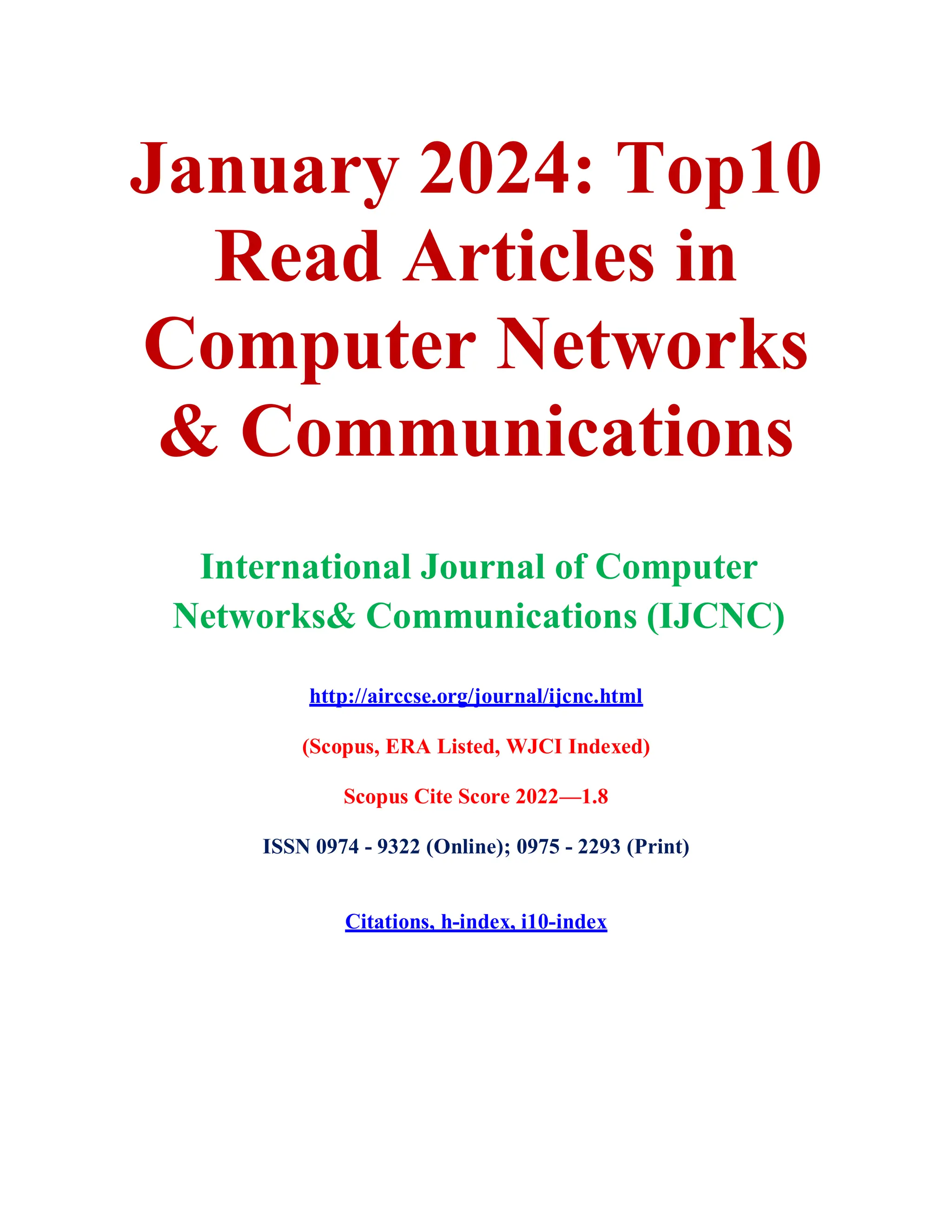
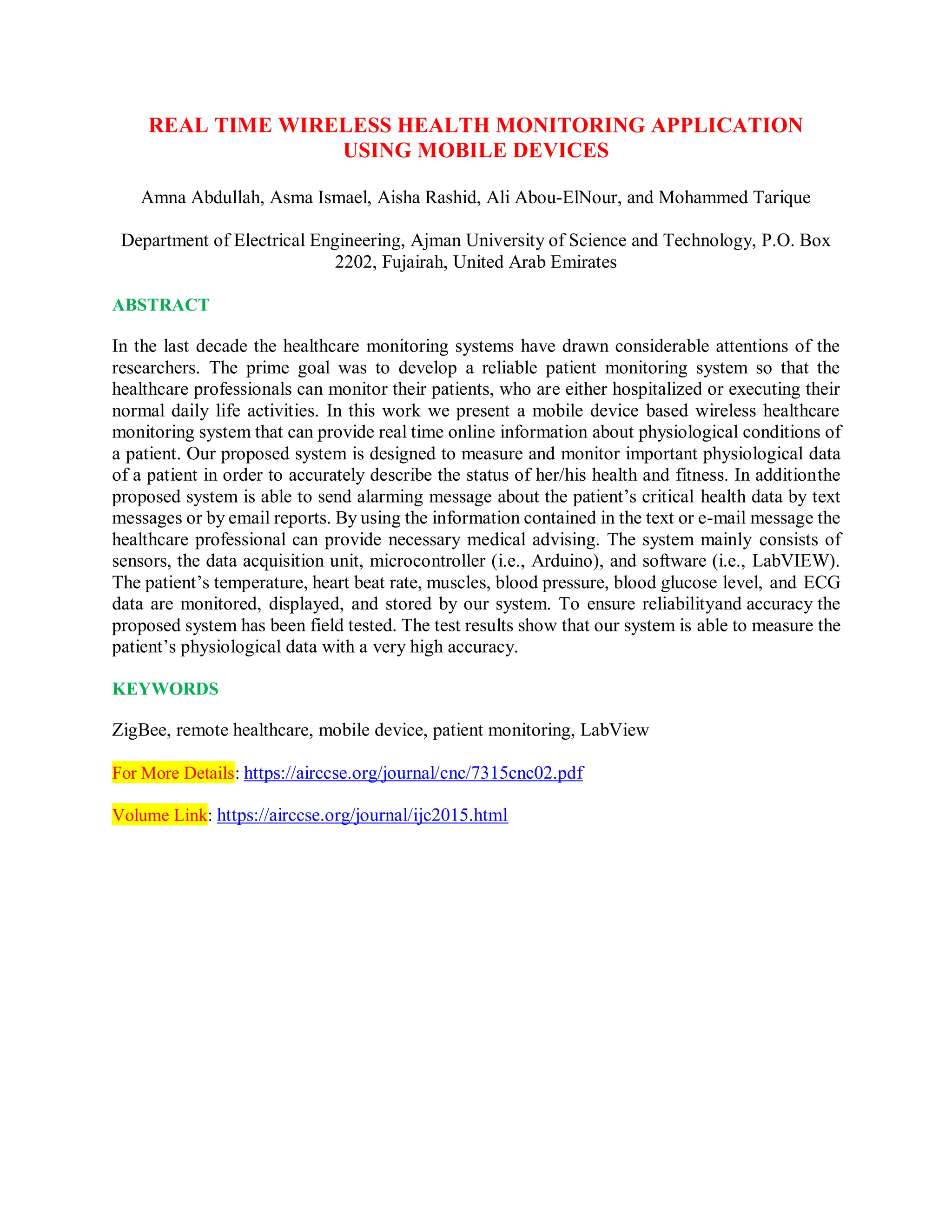
![REFERENCES
[1] Global Challenges for Humanity available at
http://www.millenniumproject.org/millennium/challenges.html
[2] A Right to Health available at http://www.who.int/mediacentre/factsheets
[3] FRANCIS S. COLLINS, “MOBILE TECHNOLOGY AND HEALTHCARE”,
AVAILABLE at http://www.nlm.nih.gov/medlineplus/magazine/issues/winter11
[4] How the Smartphone Can Revolutionize Healthcare available at http://www.mdtmag.com/
[5] mHealth App Developer Economics(2014) available at
http://mhealtheconomics.com/mhealthdeveloper-economics-report/
[6] Bourouis, A., Feham, M., and Bouchachia, A.(2011), “ Ubiquitous Mobile Health Monitoring
System for Elderly (UMHMSE)”, International Journal of Computer Science and Information
Technology, Vol.2, No. 3, June, pp. 74-82
[7] Lee, Y.D. and Chung, W.Y. (2009) “Wireless Sensor Network Based Wearable Smart Shirt
for Ubiquitous Health and Activity Monitoring”, Sensors and Actuators B: Chameical, Vol. 140,
No. 2, July, pp. 390-395
[8] Orlando R. E. P., Caldeira, M. L. P. Lei S., and Rodrigues, J.P.C (2014), “An Efficient and
Low Cost Windows Mobile BSN Monitoring SystemBased on TinyOS”, Journal of
Telecommunication Systems, Vol. 54, No. 1, pp. 1-9
[9] Yuce, M. R.(2010)” Implementation of wireless body area networks for healthcare systems”,
Sensor and Actuators A:Physical, Vol. 162, No. 1, July, pp. 116-129
[10] Lei Clifton, David A. Clifton, Marco A. F. Pimentel, Peter J. Watkinson, and Lionel
Tarassenko (2014),” Predictive Monitoring of Mobile Patients by Combining Clinical
Observations with Data From Wearable Sensors”, IEEE Journal of Biomedical and Health
Informatics, Vol. 18, No. 3, May , pp. 722-730
[11] Parane, K.A., Patil, N.C. ; Poojara, S.R. ; Kamble, T.S(2014) “Cloud based Intelligent
Healthcare Monitoring System”, In the proceedings of International Conference on Issues and
Challenges in Intelligent Computing Techniques (ICICT), February 7-8, Ghaziabad, Indian, pp.
697-701
[12] Xiaoliang Wang ; Qiong Gui ; Bingwei Liu ; Zhanpeng Jin et al (2014), “Enabling Smart
Personalized Healthcare: A Hybrid Mobile-Cloud Approach for ECG Telemonitoring”, IEEE
Journal of Biomedical and Health Informatics, Vol. 18, No. 3, May, pp. 739 – 745
[13] Dunsmuir, D., Payne, B. ; Cloete, G. ; Petersen, C.(2014), “Development of m-Health
Applications for Pre-eclampsia Triage”, IEEE Journal of Biomedical and Health Informatics, Vol.
PP, No. 99, January , pp. 2168-2194](https://image.slidesharecdn.com/january2024top10readarticlesincomputernetworkscommunications-240201053401-d5abe0da/75/January_2024-Top-10-Read-Articles-in-Computer-Networks-Communications-pdf-3-2048.jpg)
![[14] Tello, J.P. ; Manjarres, O. ; Quijano, M. ; Blanco, A. et al(2013) , “ Remote Monitoring
System of ECG and Human Body Temperature Signals”, IEEE Latin American Transaction,
Vol. 11, No. 1, February, pp. 314-318
[15] Moreira, H. ; Oliveira, R. ; Flores, N.(2013), “STAlz: Remotely supporting the diagnosis,
tracking and rehabilitation of patients with Alzheimer's”, In the Proceedings of the 15th IEEE
Conference on E-health Networking, Applications, and Services, October 9-12, Lisbob, pp. 580-
584
[16] Touati, F. ; Tabish, R. ; and Ben Mnaouer, A.(2013), “Towards u-health: An indoor
6LoWPAN based platform for real-time healthcare monitoring”, In the proceedings of the IFIP
International Conference on Wireless and Mobile Networking, April 20-23, 2013,Dubai, pp. 1-4
[17] Strisland, F. ; Sintef,; Svagard, I. ; Seeberg, T.M.(2013) “ESUMS: A mobile system for
continuous home monitoring of rehabilitation patient”, In the proceedings of the 35th IEEE Annual
International Conference on Engineering in Medicine and Biology Society, July 3-7, 2013, Osaka,
pp. 4670-4673
[18] Yun-Hong Noh ; Jiunn Huei Yap ; and Do-Un Jeong(2013) “Implementation of the
Abnormal ECG Monitoring System Using Heartbeat Check Map Technique”, In the proceedings
of International Conference on IT Convergence and Security, December 16-18, 2013, Macao, pp.
1-4
[19] Triantafyllidis, A.K. ; Koutkias, V.G. ; Chouvarda, I. ; Maglaveras, N.(2013) “A Pervasive
Health System Integrating Patient Monitoring, Status Logging, and Social Sharing”, IEEE Journal
on Biomedical and Health Informatics, Vol. 17, No. 1, January , pp. 30-37
[20] Bin Yu ; Lisheng Xu ; Yongxu Li(2012) “Bluetooth Low Energy (BLE) based mobile
electrocardiogram monitoring system”, In the proceedings of International Conference on
Information and Automation, June 6-8, 2012, Shenyang, pp. 763-767
[21] Mitra, P. ; Poellabauer, C.(2012) ,” Emergency response in smartphone-based Mobile Ad-
Hoc Networks”, In the proceedings of IEEE International Conference on Communication, June
10-15, Ottawa, pp. 6091 - 6095
[22] Ospino, M.R. ; Ariza, L.C. ; Rojas, J.G., (2012), ”Mobile system for monitoring
measurements in hypertensive patients”, In the proceedings of the IEEE Colombian
Communication conference, May 16-18, CA, pp. 1-6
[23] Ruipeng Gao ; Liqiong Yang ; Xinyu Wu ; and Tao Wang, (2012) “A phone-based e-health
system for OSAS and its energy issue”, In the proceedings of the International Symposium on
Information Technology in Medicine and Education, August 3-5, 2012, Hokodate, Hokkaido, pp.
682-696
[24] https://www.zigbee.org/](https://image.slidesharecdn.com/january2024top10readarticlesincomputernetworkscommunications-240201053401-d5abe0da/75/January_2024-Top-10-Read-Articles-in-Computer-Networks-Communications-pdf-4-2048.jpg)
![[25] The IEEE 802.15.4 standard available at
http://standards.ieee.org/getieee802/download/802.15.4d2009.pdf
Bluetooth Developer Portal available at
https://developer.bluetooth.org/TechnologyOverview/Pages/Compare.aspx](https://image.slidesharecdn.com/january2024top10readarticlesincomputernetworkscommunications-240201053401-d5abe0da/75/January_2024-Top-10-Read-Articles-in-Computer-Networks-Communications-pdf-5-2048.jpg)
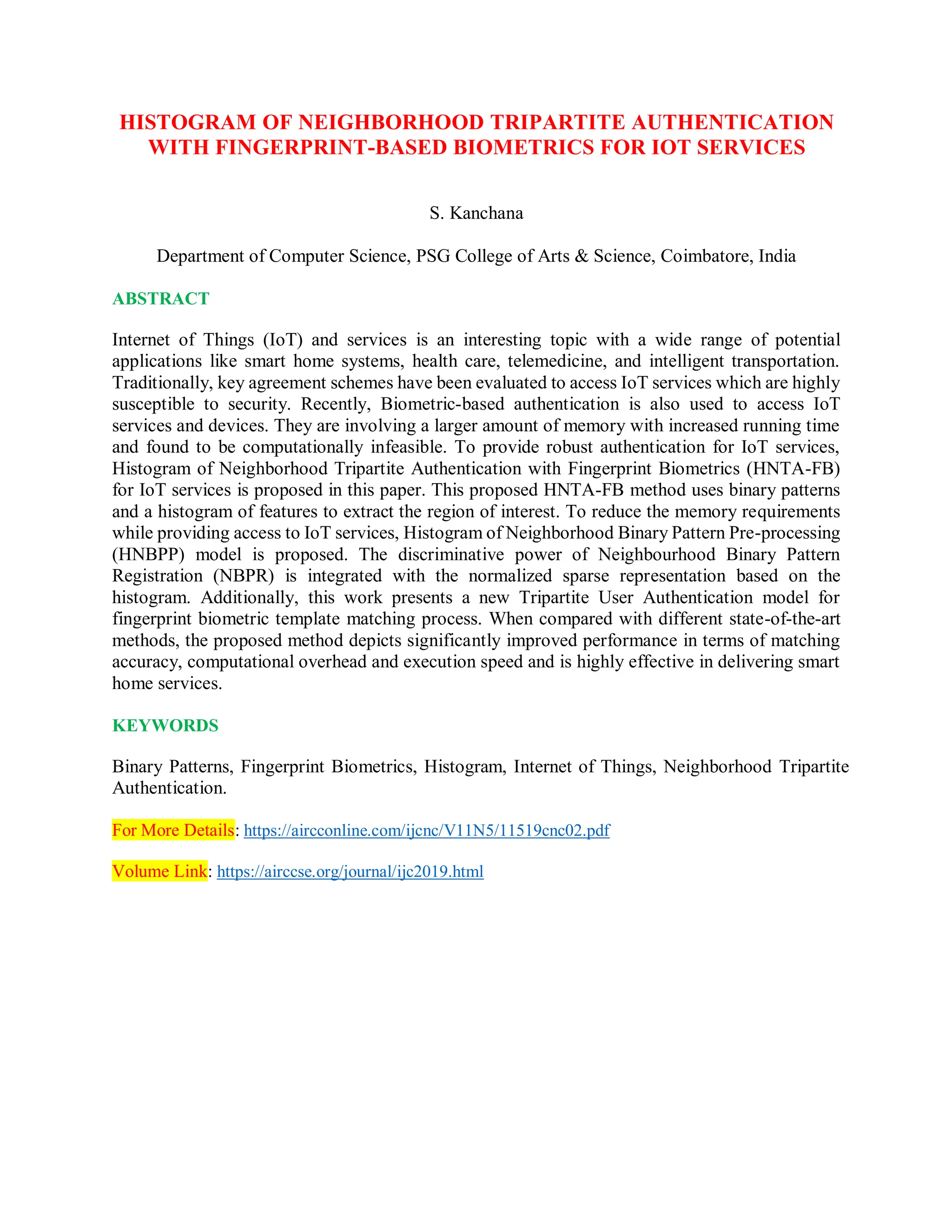
![REFERENCES
[1] Munish Bhatia, Sandeep K. Sood, “A comprehensive health assessment framework to facilitate
IoTassisted smart workouts: A predictive healthcare perspective”, Computers in Industry, Elsevier,
2017. https://doi.org/10.1016/j.compind.2017.06.009 .
[2] Parwinder Kaur Dhillon, Sheetal Kalra, “A lightweight biometrics based remote user
authentication scheme for IoT services”, Journal of Information Security and Applications, Elsevier,
2017. https://doi.org/10.1016/j.jisa.2017.01.003
[3] Ortega-Garcia, Javier, “The multi scenario multi environment biosecure multimodal database"
IEEE Transactions on Pattern Analysis and Machine Intelligence, 2010.
https://doi.org/10.1109/tpami.2009.76
[4] Jun Xu, Xiong Zhang, and Meng Zhou, “A High-Security and Smart Interaction System Based
on Hand Gesture Recognition for Internet of Things”, Hindawi, Security and Communication
Networks, 2018. https://doi.org/10.1155/2018/4879496
[5] Li Yang, Zhiming Zheng, “Cryptanalysis and improvement of a biometrics-based authentication
and key agreement scheme for multi-server environments”, PLOS ONE, 2018,
https://doi.org/10.1371/journal.pone.0194093
[6] M. Shamim Hossain et al., “Toward End-to-End Biometrics-Based Security for IoT
Infrastructure”, IEEE Wireless Communications, 2016. https://doi.org/10.1109/mwc.2016.7721741
[7] Younsung Choi, Youngsook Lee, Jongho Moon, Dongho Won, “Security enhanced multi-factor
biometric authentication scheme using bio-hash function”, PLOS ONE, 2017.
https://doi.org/10.1371/journal.pone.0176250.
[8] Seyedehsamaneh Shojaeilangari, Wei-Yun Yau, Karthik Nandakumar, Li Jun, Eam Khwang
Teoh, “Robust Representation and Recognition of Facial Emotions Using Extreme Sparse Learning”,
IEEE Transactions on Image Processing, 2015. https://doi.org/10.1109/tip.2015.2416634
[9] Juan S. Arteaga-Falconi, Hussein Al Osman, Abdulmotaleb El Saddik, “ECG and Fingerprint
Bimodal Authentication”, Sustainable Cities and Society, Elsevier, 2017.
https://doi.org/10.1016/j.scs.2017.12.023
[10] Pedro Peris-Lopez, Lorena Gonzalez-Manzano, Carmen Camara, Jose Maria de Fuentes, “Effect
of attacker characterization in ECG-based continuous authentication mechanisms for Internet of
Things”, Future Generation Computer Systems, Elsevier, 2017.
https://doi.org/10.1016/j.future.2017.11.037
[11] Haibo Yi, Zhe Nie, “Side-channel security analysis of UOV signature for cloud-based Internet
of Things”, Future Generation Computer Systems, Elsevier, 2018.
https://doi.org/10.1016/j.future.2018.04.083
[12] Wencheng Yang, Jiankun Hu, Song Wang, Qianhong Wu, “Biometrics Based Privacy-
Preserving Authentication and Mobile Template Protection”, Hindawi Wireless Communications
and Mobile Computing, 2018. https://doi.org/10.1155/2018/7107295
[13] Dong-Hwan Park, Hyo-Chan Bang, Cheol Sik Pyo, Soon-Ju Kang, “Semantic Open IoT Service](https://image.slidesharecdn.com/january2024top10readarticlesincomputernetworkscommunications-240201053401-d5abe0da/75/January_2024-Top-10-Read-Articles-in-Computer-Networks-Communications-pdf-7-2048.jpg)
![Platform Technology”, IEEE World Forum on Internet of Things, 2014.
https://doi.org/10.1109/wfiot.2014.6803125
[14] Igor Miladinovic, Sigrid Schefer-Wenzl, “NFV Enabled IoT Architecture for an Operating
Room Environment”, IEEE 4th World Forum on Internet of Things (WF-IoT), 2018.
https://doi.org/10.1109/wf-iot.2018.8355128
[15] Paul Loh Ruen Chze, Kan Siew Leong, “A Secure Multi-Hop Routing for IoT Communication”,
IEEE World Forum on Internet of Things (WF-IoT), 2014.
https://doi.org/10.1109/wfiot.2014.6803204
[16] Shulong Wang, Yibin Hou, Fang Gao, Xinrong Ji, “A Novel IoT Access Architecture for
Vehicle Monitoring System”, IEEE 3rd World Forum on Internet of Things , 2016.
https://doi.org/10.1109/wf-iot.2016.7845396
[17] Jong Hyuk Park, Neil Yuwen Yen, “Advanced algorithms and applications based on IoT for the
smart Devices”, Journal of Ambient Intelligence and Humanized Computing, 2018.
https://doi.org/10.1007/s12652-018-0715-5
[18] Lavinia, Mihaela, Dinca, Gerhard Petrus Hancke, “The Fall of One, the Rise of Many: A Survey
on Multi-Biometric Fusion Methods”, IEEE Access (Volume: 5), 2017.
https://doi.org/10.1109/access.2017.2694050
[19] Yaman Sharaf-Dabbagh, Walid Saad, “Demo Abstract: Cyber-Physical Fingerprinting for
Internet of Things Authentication”, ACM/IEEE Second International Conference on Internet-of-
Things Design and Implementation (IoTDI), 2017. https://doi.org/10.1145/3054977.3057323](https://image.slidesharecdn.com/january2024top10readarticlesincomputernetworkscommunications-240201053401-d5abe0da/75/January_2024-Top-10-Read-Articles-in-Computer-Networks-Communications-pdf-8-2048.jpg)
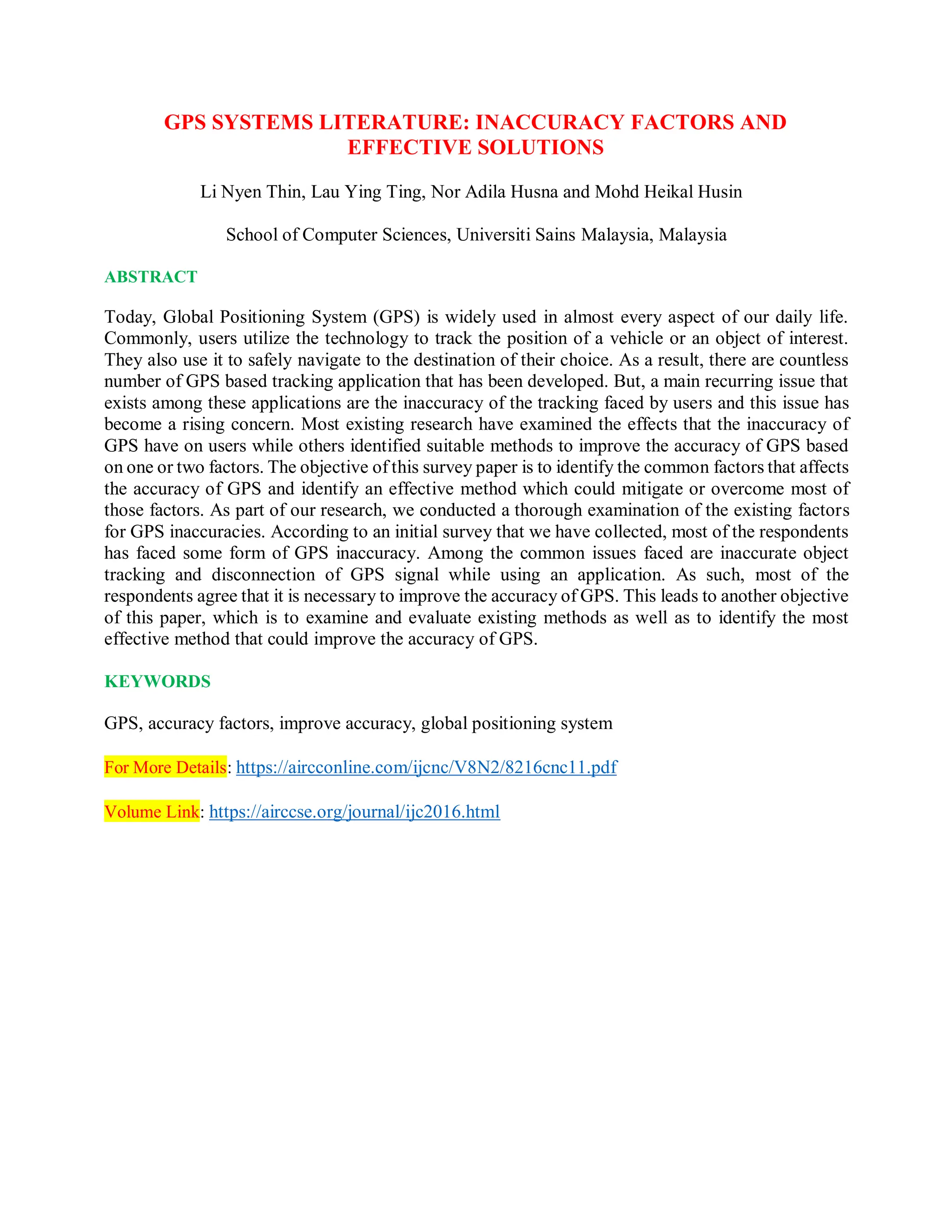
![REFERENCES
[1] Lin, J.Y, Yang, B.K., Tuan A.D., and Chen, H.C. (2013). “The Accuracy Enhancement of GPS
Track in Google Map”, 2013 Eighth International Conference on Broadband and Wireless
Computing, Communication and Applications, Compiegne, France. pp. 524-527.
[2] Iqbal, A., Mahmood. H., Farooq, U., Kabir, M.A. and Asad, M.U.. (2009). “An Overview of the
Factors Responsible for GPS Signal Error: Origin and Solution”, 2009 International Conference on
Wireless Networks and Information Systems, Shanghai, China. pp. 294-299.
[3] Bajaj, R., Ranaweera, S.L., Agrawal, D.P.. (2002). “GPS: Location-tracking Technology”,
Computer, vol.35, no..4, pp. 92-94.
[4] Huang, J.Y., and Tsai, C.H.. (2008). “Improve GPS Positioning Accuracy with Context
Awareness”, 2008 First IEEE International Conference on Ubi-Media Computing, Lanzhou, China,
pp. 94-99.
[5] Wubbena, G., Andreas, B., Seeber, G., Boder, V. and Hankemeier, P., (1996). “Reducing
Distance Dependant Errors for Real-Time Precise DGPS Applications by Establishing Reference
Station Networks”. In Proceedings of the 9th International Technical Meeting of the Satellite
Division of the Institute of Navigation (ION GPS-96)
[6] Enge, P., Walter, T., Pullen, S., Kee, C., Chao, Y. and Tsai, Y. (1996). “Wide area augmentation
of the global positioning system”. Proceedings of the IEEE, vol. 84 Aug. 1996, pp. 1063–1088.
[7] Qi, H. and Moore, J. B. (2002). “Direct Kalman Filtering Approach for GPS/INS Integration”,
IEEE Trans. Aerosp, Electron. System. vol. 38, no. 2, 2002, pp. 687-693.
[8] Malleswari, B.L., MuraliKrishna, I.V., Lalkishore, K., Seetha, M., Nagaratna, P. H. “The Role of
Kalman Filter in the Modelling of GPS Errors”, Journal of Theoretical and Applied Information
Technology, pp. 95-101.
[9] White, C.E., Bernstein, D. and Kornhauser, Alain L.. (2000). “Some map matching algorithms
for personal navigation assistants”. Transportation Research Part C, No. 8, 2000, pp. 91-108.](https://image.slidesharecdn.com/january2024top10readarticlesincomputernetworkscommunications-240201053401-d5abe0da/75/January_2024-Top-10-Read-Articles-in-Computer-Networks-Communications-pdf-10-2048.jpg)
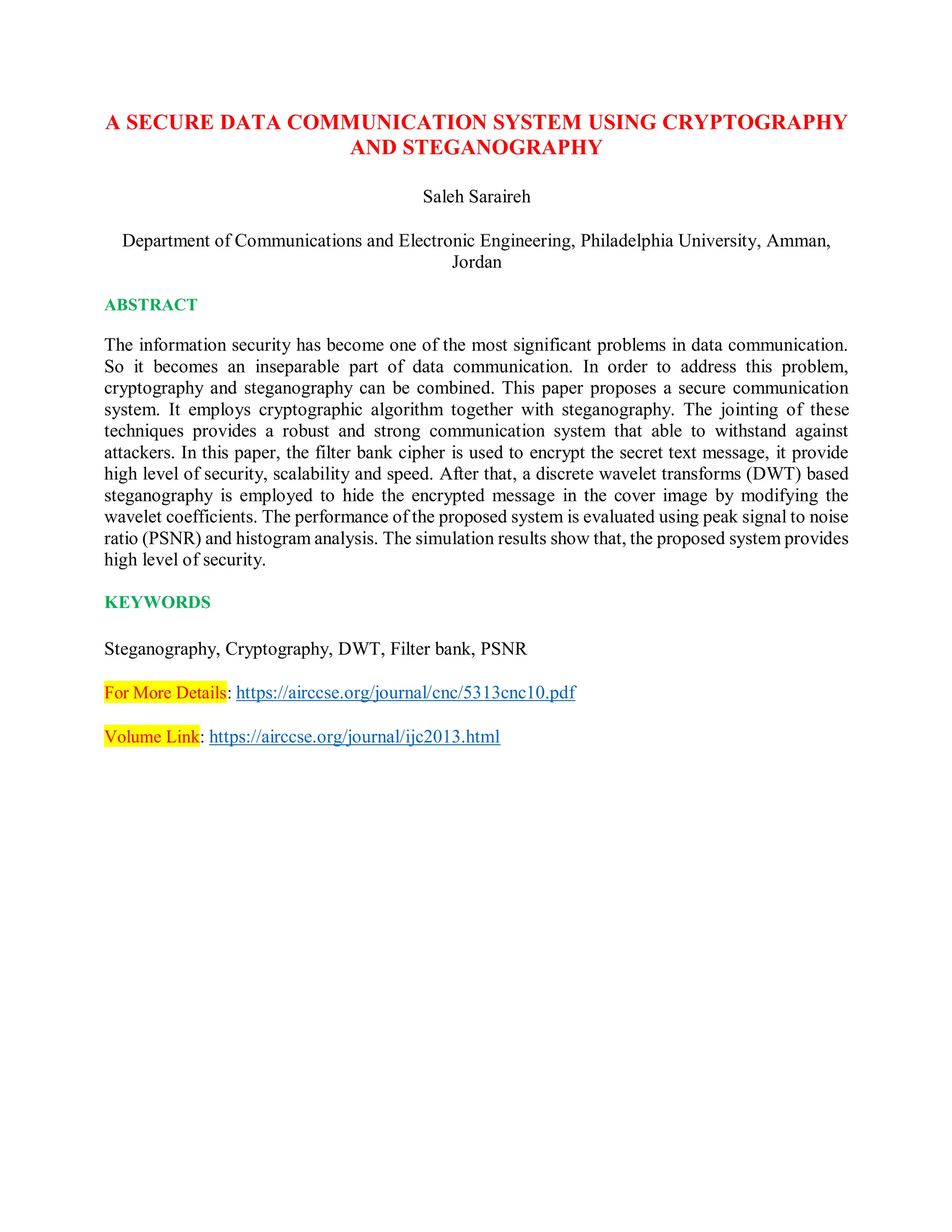
![REFERENCES
[1] Obaida Mohammad Awad Al-Hazaimeh, (2013) "A New Approach for Complex Encrypting and
Decrypting Data" International Journal of Computer Networks & Communications (IJCNC) Vol.5,
No.2.
[2] Katzenbeisser, S. and Petitcolas, F.A.P. 2000, Information Hiding Techniques for Steganography
and Digital Watermarking. Artech House, Inc., Boston, London.
[3] Xinpeng Zhang and Shuozhong Wang, (2005), "Steganography Using MultipleBase Notational
System and Human Vision Sensitivity", IEEE signal processing letters, Vol. 12, No. 1.
[4] Jarno Mielikainen, (2006), "LSB Matching Revisited", IEEE signal processing letters, Vol. 13,
No. 5.
[5] Piyush Marwaha, Paresh Marwaha, (2010), "Visual Cryptographic Steganography in images",
IEEE, 2nd International conference on Computing, Communication and Networking Technologies.
[6] G.Karthigai Seivi, Leon Mariadhasan and K. L. Shunmuganathan, (2012), " Steganography Using
Edge Adaptive Image " IEEE, International Conference on Computing, Electronics and Electrical
Technologies.
[7] Hemalatha S, U Dinesh Acharya, Renuka A and Priya R. Kamath, (2012), " A Secure and High
Capacity Image Steganography Technique", Signal & Image Processing : An International Journal
(SIPIJ) Vol.4, No.1.
[8] Tong L.and Zheng-ding, Q, (2002), "DWT-based color Images Steganography Scheme", IEEE
International Conference on Signal Processing, 2:1568-1571.
[9] Mandal J.K. and Sengupta M., (2010), “Authentication/Secret Message Transformation Through
Wavelet Transform based Subband Image Coding (WTSIC).”, Proceedings of International
Symposium on Electronic System Design, IEEE Conference Publications, pp 225 – 229.
[10] Septimiu F. M., Mircea Vladutiu and Lucian P., (2011),"Secret data communication system
using Steganography, AES and RSA", IEEE 17th International Symposium for Design and
Technology in Electronic Packaging.
[11] H. Tian, K. Zhou, Y. Huang, D. Feng, J. Liu, (2008), "A Covert Communication Model Based
on Least Significant Bits Steganography in Voice over IP", IEEE The 9th International Conference
for Young Computer Scientists, pp. 647-652.
[12] Y. Huang, B. Xiao, H. Xiao, (2008), "Implementation of Covert Communication Based on
Steganography", IEEE International Conference on Intelligent Information Hiding and Multimedia
Signal Processing, pp. 1512-1515.
[13] Cheddad, A, Condell, Joan, Curran, K and McKevitt, Paul,(2008), "Securing Information
Content using New Encryption Method and Steganography", IEEE Third International Conference
on Digital Information Management.
[14] Rasul E., Saed F. and Hossein S, (2009), " Using the Chaotic Map in Image Steganography",](https://image.slidesharecdn.com/january2024top10readarticlesincomputernetworkscommunications-240201053401-d5abe0da/75/January_2024-Top-10-Read-Articles-in-Computer-Networks-Communications-pdf-12-2048.jpg)
![IEEE, International Conference on Signal Processing Systems.
[15] Majunatha R. H. S. and Raja K B, (2010), "High Capacity and Security Steganography using
Discrete Wavelet Transform", International Journal of Computer Science and Security (IJCSS), Vol.
3: Issue (6) pp 462-472.
[16] Saraireh S. and Benaissa M., (2009), “A Scalable Block Cipher Design using Filter Banks and
Lifting over Finite Fields” In IEEE International Conference on Communications (ICC), Dresden,
Germany.
[17] El Safy, R.O, Zayed. H. H, El Dessouki. A, (2009), “An adaptive steganography technique based
on integer wavelet transform,” ICNM International Conference on Networking and Media
Convergence, pp 111-117.](https://image.slidesharecdn.com/january2024top10readarticlesincomputernetworkscommunications-240201053401-d5abe0da/75/January_2024-Top-10-Read-Articles-in-Computer-Networks-Communications-pdf-13-2048.jpg)
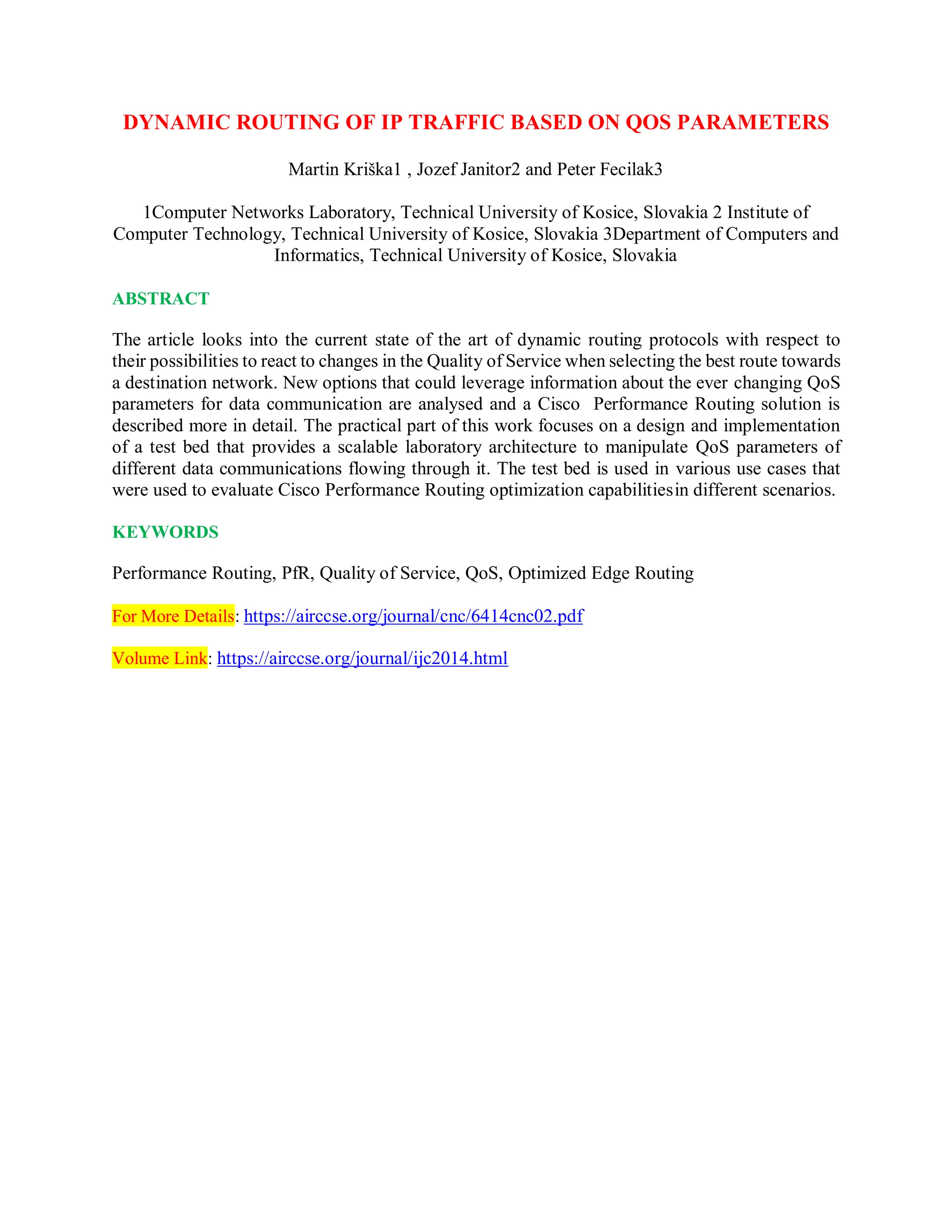
![REFERENCES
[1] Information Sciences Institute, University of Southern California. RFC 791 INTERNET
PROTOCOL - DARPA INTERNET PROGRAM, PROTOCOL SPECIFICATION. s.l. : Internet
Engineering Task Force, 1981.
[2] Cisco Systems, Inc. Route Selection in Cisco Routers. Cisco. [Online] 2008. [Date: 25th of
October 2013.] http://www.cisco.com/image/gif/paws/8651/21.pdf.
[3] D. Savage, et. al.: Enhanced Interior Gateway Routing Protocol. IETF. [Online] 2013 [Date:
25th of October 2013.] http://tools.ietf.org/html/draft-savage-eigrp-00.
[4] Teare Diane: Implementing Cisco IP Routing (ROUTE) Foundation Learning Guide.
Indianapolis: Cisco Press, 2010. ISBN 1587058820.
[5] Cisco Systems, Inc. BGP Best Path Selection Algorithm. Cisco. [Online] 2012. [Date: 25th of
October 2013.] http://www.cisco.com/image/gif/paws/13753/25.pdf.
[6] Doyle Jeff, Carroll Jennifer: CCIE Professional Development Routing TCP/IP Volume I.
Indianapolis: Cisco Press, 2006. ISBN 1587052024.
[7] D. Awduche, et. al.: RSVP-TE: Extensions to RSVP for LSP Tunnels. IETF. [Online] 2013
[Date: 11th of November 2013.] http://tools.ietf.org/html/rfc3209.
[8] X. Fu, et. al.: RSVP-TE extensions for Loss and Delay Traffic Engineering. IETF. [Online]
2013 [Date: 11th of November 2013.] http://tools.ietf.org/html/draft-fuxh-mpls-delay-loss-rsvp-
te-ext02.
[9] Z. Seils. Defining SDN Overview of SDN Terminology & Concepts. Cisco. [Online] 2013.
[Date: 4 th of October 2013.] https://learningnetwork.cisco.com/docs/DOC-21946.
[10] Cisco Systems, Inc. onePK Chat and Demo at Cisco Live. SlideShare. [Online] 2012. [Date:
4th of October 2013.] http://www.slideshare.net/getyourbuildon/onepk-chat-and-demo-at-cisco-
live.
[11] S. Cadora. Hitchhiker's Guide to onePK. Cisco. [Online] 2013. [Date: 12th of September
2013.] https://learningnetwork.cisco.com/docs/DOC-22910.
[12] R. Trunk. Understanding Performance Routing (PfR). Chesapeake Netcraftsmen. [Online]
2009. [Date: 15th of November 2013.] http://netcraftsmen.net/archived-documents/c-mug-
articlearchive/7-20090922-cmug-understanding-performance-routing/file.html?limit=10.
[13] Kalita Hemanta Kumar, Nambiar Manoj K.: Designing WANem: A Wide Area Network
Emulator tool. Bangalore, 2011. ISBN 9780769546186.
[14] R. Pandi Selvam, V.Palanisamy: An efficient cluster based approach for multi-source
multicast routing protocol in mobile ad hoc networks, International Journal of Computer](https://image.slidesharecdn.com/january2024top10readarticlesincomputernetworkscommunications-240201053401-d5abe0da/75/January_2024-Top-10-Read-Articles-in-Computer-Networks-Communications-pdf-15-2048.jpg)
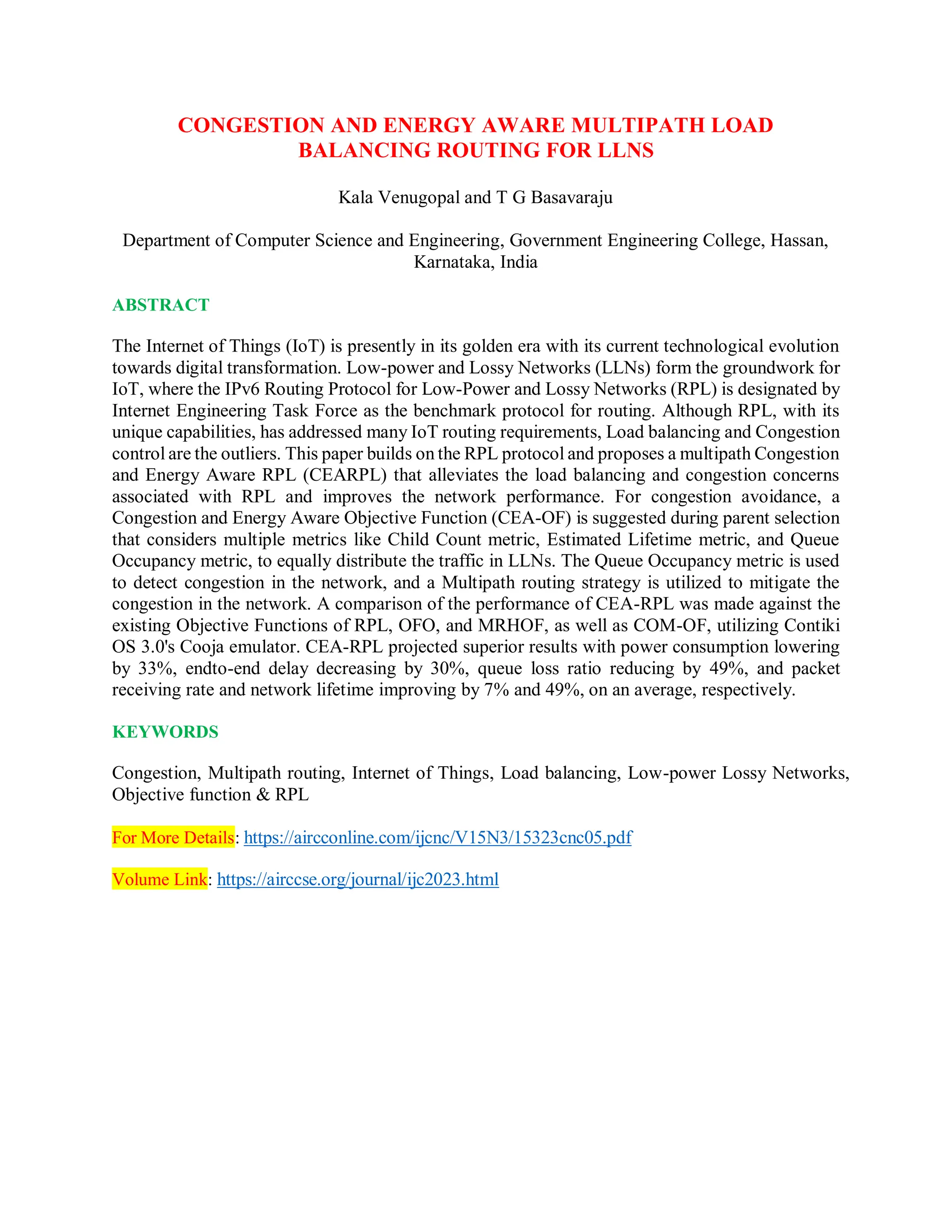
![REFERENCES
[1] https://dataprot.net/statistics/iot-statistics/
[2] T. Winter et al., (2012) “RPL: IPv6 Routing Protocol for Low-Power and Lossy Networks”, IETF
RFC 6550.
[3] The Internet Engineering Task Force (IETF), 2010. .
[4] Routing Over Low Power and Lossy Networks (ROLL), 2004.
[5] O. Gaddour & A. Koubaa, (2012) “RPL in a nutshell: A survey”, Elsevier, Computer Networks,
Volume 56, Issue 14, Pages 3163-3178, doi: 10.1016/j.comnet.2012.06.016
[6] Doruk Pancaroglu, Sevil Sen, (2021) “Load balancing for RPL-based Internet of Things: A
review”, Ad Hoc Networks, Volume 116, 102491, ISSN 1570-8705,
https://doi.org/10.1016/j.adhoc.2021.102491.
[7] B. G. Mamoun Qasem, Ahmed Al-Dubai & Imed Romdhani, (2017) “Load balancing objective
function in RPL”, ROLL – WG INTERNET DRAFT, pp. 1–10
[8] C, Lim, (2019) "A Survey on Congestion Control for RPL-Based Wireless Sensor Networks",
Sensors 19, no. 11: 2567. https://doi.org/10.3390/s19112567
[9] P. Thubert, (2012) “Objective function zero for the routing protocol for low-power and lossy
networks (RPL)”, RFC 6552.
[10] O. Gnawali & P. Levis, (2012) “The Minimum Rank with Hysteresis Objective Function”, RFC
6719
[11] Ibrahim S. Alsukayti, (2020) “The support of multipath routing in IPv6-based internet of
things”, International Journal of Electrical and Computer Engineering (IJECE). 10. 2208.
10.11591/ijece.v10i2.pp2208-2220.
[12] J. Tsai & T. Moors, (2006) “A Review of Multipath Routing Protocols: From Wireless Ad Hoc
to Mesh Networks”, 17-18 July
[13] M. Geuzouri, N. Mbarek & A. Temar, (2020) A new way of achieving multipath routing in
wireless networks”, International Journal of Wireless and Mobile Computing. 18. 101.
10.1504/IJWMC.2020.10026464.
[14] A. Bhat & V. Geetha, (2017) "Survey on routing protocols for Internet of Things”, 7th
International Symposium on Embedded Computing and System Design (ISED), pp. 1-5, doi:
10.1109/ISED.2017.8303949.
[15] O. Iova, F. Theoleyre & T. Noel, (2015) “Exploiting multiple parents in RPL to improve both
the network lifetime and its stability", 2015 IEEE International Conference on Communications
(ICC), pp. 610-616, doi: 10.1109/ICC.2015.7248389.
[16] M. A. Lodhi, A. Rehman, M. M. Khan & F. B. Hussain, (2015) "Multiple path RPL for low
power lossy networks", 2015 IEEE Asia Pacific Conference on Wireless and Mobile (APWiMob),](https://image.slidesharecdn.com/january2024top10readarticlesincomputernetworkscommunications-240201053401-d5abe0da/75/January_2024-Top-10-Read-Articles-in-Computer-Networks-Communications-pdf-17-2048.jpg)
![pp. 279- 284, doi: 10.1109/APWiMob.2015.7374975.
[17] P. Levis, T. Clausen, J. Hui, O. Gnawali & J. Ko, (2011) “The trickle algorithm", March 2011,
IETF RFC 6206.
[18] Q. Le, T. Ngo-Quynh & T. Magedanz, (2014) "RPL-based multipath Routing Protocols for
Internet of Things on Wireless Sensor Networks", 2014 International Conference on Advanced
Technologies for Communications (ATC 2014), pp. 424-429, doi: 10.1109/ATC.2014.7043425.
[19] Radi, Marjan, Behnam Dezfouli, Kamalrulnizam Abu Bakar, & Malrey Lee, (2012) "Multipath
Routing in Wireless Sensor Networks: Survey and Research Challenges", Sensors 12, no. 1: 650685.
https://doi.org/10.3390/s120100650
[20] W. Lou, W. Liu & Y. Zhang, (2006) “Performance Optimization Using Multipath Routing in
Mobile Ad Hoc and Wireless Sensor Networks”, 10.1007/0-387-29026-5_5.
[21] Z. Wang, L. Zhang, Z. Zheng et al., (2018) “Energy balancing RPL protocol with multipath for
wireless sensor networks. Peer-to-Peer Networks”, Appl. 11, 1085–1100,
https://doi.org/10.1007/s12083-017-0585-1
[22] Oana Iova, Fabrice Theoleyre & Thomas Noel, (2015) “Using Multiparent Routing in RPL to
Increase the Stability and the Lifetime of the Network”, Ad Hoc Networks, Elsevier, 29,
10.1016/j.adhoc.2015.01.020, hal-01206380
[23] M. Lodhi, Abdul Rehman, Meer Khan, M. Asfand-E-yar & F. Hussain, (2017) “Transient
multipath routing protocol for low power and lossy networks”, KSII Transactions on Internet and
Information Systems,11, 2002-2019, 10.3837/tiis.2017.04.010.
[24] T. L. Jenschke, G. Z. Papadopoulos, R. -A. Koutsiamanis & N. Montavont, (2019) "Alternative
Parent Selection for Multi-Path RPL Networks", 2019 IEEE 5th World Forum on Internet of Things
(WF-IoT), pp. 533-538, doi: 10.1109/WF-IoT.2019.8767236.
[25] Tomas Lagos Jenschke, Remous-Aris Koutsiamanis, Georgios Papadopoulos, Nicolas
Montavont, (2021) “ODeSe: On-Demand Selection for multipath RPL networks”, Ad Hoc Networks,
Elsevier, 114, pp.102431. 10.1016/j.adhoc.2021.102431. hal-03122968v2f
[26] F. Kaviani & M. Soltanaghaei, (2022) “CQARPL: Congestion and QoS-aware RPL for IoT
applications under heavy traffic”, The Journal of Supercomputing, 78, 10.1007/s11227-02204488-2.
[27] H. -S. Kim, H. Kim, J. Paek & S. Bahk, (2017) "Load Balancing Under Heavy Traffic in RPL
Routing Protocol for Low Power and Lossy Networks", in IEEE Transactions on Mobile Computing,
vol. 16, no. 4, pp. 964-979, 1 April 2017, doi: 10.1109/TMC.2016.2585107.
[28] Kala Venugopal & T. G. Basavaraju, (2022) “A Combined Metric Objective Function for RPL
Load Balancing in Internet of Things”, International Journal of Internet of Things, Vol. 10 No. 1,
2022, pp. 22-31. doi: 10.5923/j.ijit.20221001.02.
[29] S. Wakatsuki, N. Komuro, H. Sekiya & S. Sakata, (2014) “Prolonging network lifetime for
6LoWPAN / RPL wireless sensor network using mobile sink with dynamic sojourn time”, 2014
[30] M. Aboubakar, M. Kellil, A. Bouabdallah & P. Roux, (2019) “Toward intelligent](https://image.slidesharecdn.com/january2024top10readarticlesincomputernetworkscommunications-240201053401-d5abe0da/75/January_2024-Top-10-Read-Articles-in-Computer-Networks-Communications-pdf-18-2048.jpg)
![reconfiguration of RPL networks using supervised learning”, 2019 Wireless Days (WD),
Manchester, United Kingdom, pp. 1-4, 2019, DOI: 10.1109/WD.2019.8734236.
[31] Mah Zaib Jamil, Danista Khan, Adeel Saleem, Kashif Mehmood & Atif Iqbal, (2019)
“Comparative performance analysis of RPL for low power and lossy networks based on different
objective functions”, International Journal of Advanced Computer Science and Applications, Vol.
10, No. 5, DOI: 10.14569/IJACSA.2019.0100524
[32] Contiki O.S and Cooja simulator, http://www.contiki-os.org/ [33] T. Zahariadis & P. Trakadas,
(2022) “Design guidelines for routing metrics composition in LLN”, ROLL Internet Draft, 2022
[34] Nesrine Khernane, Jean Couchot & Ahmed Mostefaoui, (2018) “Maximum network lifetime
with optimal power/rate and routing trade-off for wireless multimedia sensor networks”, Computer
Communications, Elsevier, 124, pp.1 – 16, hal-02182832
[35] Moteiv Corporation. Tmote sky: Datasheet (2006):
https://insense.cs.standrews.ac.uk/files/2013/04/tmote-sky-datasheet.pdf, Nov 13, 2006
[36] H.A.A. Al-Kashoash, H. Kharrufa, Y. Al-Nidawi. et al., (2019) “Congestion control in wireless
sensor and LoWPAN Networks: toward the Internet of Things”, Wireless Netw 25, 4493-4522,
https://doi.org/10.1007/s11276-018-1743-y](https://image.slidesharecdn.com/january2024top10readarticlesincomputernetworkscommunications-240201053401-d5abe0da/75/January_2024-Top-10-Read-Articles-in-Computer-Networks-Communications-pdf-19-2048.jpg)
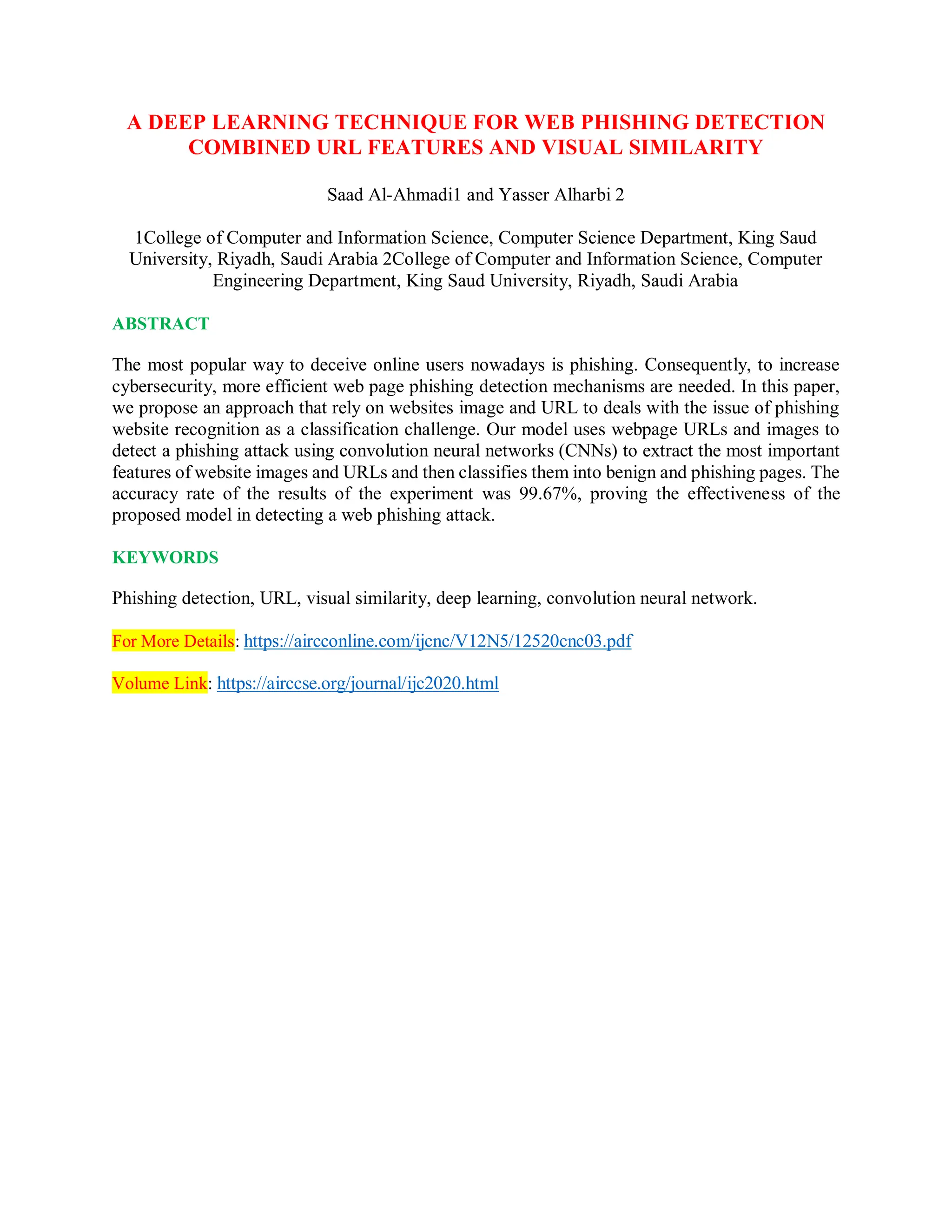
![REFERENCES
[1] H. Thakur, “Available Online at www.ijarcs.info A Survey Paper On Phishing Detection,” vol.
7, no. 4, pp. 64–68, 2016.
[2] G. Varshney, M. Misra, and P. K. Atrey, “A survey and classification of web phishing detection
schemes,” Security and Communication Networks. 2016, doi: 10.1002/sec.1674.
[3] E. S. Aung, T. Zan, and H. Yamana, “A Survey of URL-based Phishing Detection,” pp. 1–8,
2019, [Online]. Available: https://db-event.jpn.org/deim2019/post/papers/201.pdf.
[4] S. Nakayama, H. Yoshiura, and I. Echizen, “Preventing false positives in content-based phishing
detection,” in IIH-MSP 2009 - 2009 5th International Conference on Intelligent Information Hiding
and Multimedia Signal Processing, 2009, doi: 10.1109/IIH-MSP.2009.147.
[5] A. K. Jain and B. B. Gupta, “Phishing detection: Analysis of visual similarity based approaches,”
Security and Communication Networks. 2017, doi: 10.1155/2017/5421046.
[6] A. Khan, A. Sohail, U. Zahoora, and A. S. Qureshi, “A Survey of the Recent Architectures of
Deep Convolutional Neural Networks,” pp. 1–68, 2019, doi: 10.1007/s10462-020-09825-6.
[7] J. Mao et al., “Phishing page detection via learning classifiers from page layout feature,” Eurasip
J. Wirel. Commun. Netw., 2019, doi: 10.1186/s13638-019-1361-0.
[8] I. F. Lam, W. C. Xiao, S. C. Wang, and K. T. Chen, “Counteracting phishing page polymorphism:
An image layout analysis approach,” in Lecture Notes in Computer Science (including subseries
Lecture Notes in Artificial Intelligence and Lecture Notes in Bioinformatics), 2009, doi:
10.1007/978-3-642- 02617-1_28.
[9] T. C. Chen, T. Stepan, S. Dick, and J. Miller, “An anti-phishing system employing diffused
information,” ACM Trans. Inf. Syst. Secur., vol. 16, no. 4, 2014, doi: 10.1145/2584680.
[10] A. S. Bozkir and E. A. Sezer, “Use of HOG descriptors in phishing detection,” in 4th
International Symposium on Digital Forensics and Security, ISDFS 2016 - Proceeding, 2016, doi:
10.1109/ISDFS.2016.7473534.
[11] F. C. Dalgic, A. S. Bozkir, and M. Aydos, “Phish-IRIS: A New Approach for Vision Based
Brand Prediction of Phishing Web Pages via Compact Visual Descriptors,” ISMSIT 2018 - 2nd Int.
Symp. Multidiscip. Stud. Innov. Technol. Proc., 2018, doi: 10.1109/ISMSIT.2018.8567299.
[12] K. L. Chiew, E. H. Chang, S. N. Sze, and W. K. Tiong, “Utilisation of website logo for phishing
detection,” Comput. Secur., 2015, doi: 10.1016/j.cose.2015.07.006.
[13] K. L. Chiew, J. S. F. Choo, S. N. Sze, and K. S. C. Yong, “Leverage Website Favicon to Detect
Phishing Websites,” Secur. Commun. Networks, 2018, doi: 10.1155/2018/7251750.
[14] Y. Zhou, Y. Zhang, J. Xiao, Y. Wang, and W. Lin, “Visual similarity based anti-phishing with
the combination of local and global features,” in Proceedings - 2014 IEEE 13th International
Conference on Trust, Security and Privacy in Computing and Communications, TrustCom 2014,
2015, doi: 10.1109/TrustCom.2014.28.](https://image.slidesharecdn.com/january2024top10readarticlesincomputernetworkscommunications-240201053401-d5abe0da/75/January_2024-Top-10-Read-Articles-in-Computer-Networks-Communications-pdf-21-2048.jpg)
![[15] A. P. E. Rosiello, E. Kirda, C. Kruegel, and F. Ferrandi, “A layout-similarity-based approach
for detecting phishing pages,” in Proceedings of the 3rd International Conference on Security and
Privacy in Communication Networks, SecureComm, 2007, doi: 10.1109/SECCOM.2007.4550367.
[16] J. Mao, P. Li, K. Li, T. Wei, and Z. Liang, “BaitAlarm: Detecting phishing sites using similarity
in fundamental visual features,” in Proceedings - 5th International Conference on Intelligent
Networking and Collaborative Systems, INCoS 2013, 2013, doi: 10.1109/INCoS.2013.151.
[17] S. Haruta, H. Asahina, and I. Sasase, “Visual Similarity-Based Phishing Detection Scheme
Using Image and CSS with Target Website Finder,” in 2017 IEEE Global Communications
Conference, GLOBECOM 2017 - Proceedings, 2017, doi: 10.1109/GLOCOM.2017.8254506.
[18] H. Zhang, G. Liu, T. W. S. Chow, and W. Liu, “Textual and visual content-based anti-phishing:
A Bayesian approach,” IEEE Trans. Neural Networks, 2011, doi: 10.1109/TNN.2011.2161999.
[19] E. Medvet, E. Kirda, and C. Kruegel, “Visual-similarity-based phishing detection,” Proc. 4th
Int. Conf. Secur. Priv. Commun. Networks, Secur., no. September 2008, 2008, doi:
10.1145/1460877.1460905.
[20] S. G. Selvaganapathy, M. Nivaashini, and H. P. Natarajan, “Deep belief network based detection
and categorization of malicious URLs,” Inf. Secur. J., vol. 27, no. 3, pp. 145–161, 2018, doi:
10.1080/19393555.2018.1456577.
[21] Y. Ding, N. Luktarhan, K. Li, and W. Slamu, “A keyword-based combination approach for
detecting phishing webpages,” Comput. Secur., vol. 84, pp. 256–275, 2019, doi:
10.1016/j.cose.2019.03.018.
[22] H. huan Wang, L. Yu, S. wei Tian, Y. fang Peng, and X. jun Pei, “Bidirectional LSTM Malicious
webpages detection algorithm based on convolutional neural network and independent recurrent
neural network,” Appl. Intell., vol. 49, no. 8, pp. 3016–3026, 2019, doi: 10.1007/s10489-019-01433-
4.
[23] M. Zouina and B. Outtaj, “A novel lightweight URL phishing detection system using SVM and
similarity index,” Human-centric Comput. Inf. Sci., vol. 7, no. 1, pp. 1–13, 2017, doi:
10.1186/s13673-017-0098-1.
[24] S. Parekh, D. Parikh, S. Kotak, and S. Sankhe, “A New Method for Detection of Phishing
Websites: URL Detection,” Proc. Int. Conf. Inven. Commun. Comput. Technol. ICICCT 2018, no.
Icicct, pp. 949–952, 2018, doi: 10.1109/ICICCT.2018.8473085.
[25] H. Le, Q. Pham, D. Sahoo, and S. C. H. Hoi, “URLNet: Learning a URL Representation with
Deep Learning for Malicious URL Detection,” no. i, 2018, [Online]. Available:
http://arxiv.org/abs/1802.03162.
[26] J. Saxe and K. Berlin, “eXpose: A Character-Level Convolutional Neural Network with
Embeddings For Detecting Malicious URLs, File Paths and Registry Keys,” 2017, [Online].
Available: http://arxiv.org/abs/1702.08568.
[27] K. Shima et al., “Classification of URL bitstreams using bag of bytes,” 21st Conf. Innov. Clouds,
Internet Networks, ICIN 2018, pp. 1–5, 2018, doi: 10.1109/ICIN.2018.8401597.](https://image.slidesharecdn.com/january2024top10readarticlesincomputernetworkscommunications-240201053401-d5abe0da/75/January_2024-Top-10-Read-Articles-in-Computer-Networks-Communications-pdf-22-2048.jpg)
![[28] R. Vinayakumar, K. P. Soman, and P. Poornachandran, “Evaluating deep learning approaches
to characterize and classify malicious URL’s,” J. Intell. Fuzzy Syst., vol. 34, no. 3, pp. 1333–1343,
2018, doi: 10.3233/JIFS-169429.
[29] O. K. Sahingoz, E. Buber, O. Demir, and B. Diri, “Machine learning based phishing detection
from URLs,” Expert Syst. Appl., vol. 117, pp. 345–357, 2019, doi: 10.1016/j.eswa.2018.09.029.
[30] W. Wang, F. Zhang, X. Luo, and S. Zhang, “PDRCNN: Precise Phishing Detection with
Recurrent Convolutional Neural Networks,” Secur. Commun. Networks, 2019, doi:
10.1155/2019/2595794.
[31] S. Khan, H. Rahmani, S. A. A. Shah, and M. Bennamoun, “A Guide to Convolutional Neural
Networks for Computer Vision,” Synth. Lect. Comput. Vis., 2018, doi:
10.2200/s00822ed1v01y201712cov015.
[32] V. Karthikeyani and S. Nagarajan, “Machine Learning Classification Algorithms to Recognize
Chart Types in Portable Document Format (PDF) Files,” Int. J. Comput. Appl., 2012, doi:
10.5120/4789- 6997.
[33] M. A. Adebowale, K. T. Lwin, and M. A. Hossain, “Deep learning with convolutional neural
network and long short-term memory for phishing detection,” 2019 13th Int. Conf. Software,
Knowledge, Inf. Manag. Appl. Ski. 2019, no. March 2019, doi:
10.1109/SKIMA47702.2019.8982427.
[34] C. Opara, B. Wei, and Y. Chen, “HTMLPhish: Enabling Phishing Web Page Detection by
Applying Deep Learning Techniques on HTML Analysis,” no. October 2018, 2019, [Online].
Available: http://arxiv.org/abs/1909.01135.](https://image.slidesharecdn.com/january2024top10readarticlesincomputernetworkscommunications-240201053401-d5abe0da/75/January_2024-Top-10-Read-Articles-in-Computer-Networks-Communications-pdf-23-2048.jpg)

![REFERENCES
[1] N. Feamster, J. Rexford, and E. Zegura, “The Road to SDN: An Intellectual History of
Programmable Networks,” ACM Queue, New York, NY, USA, Tech. Rep., 2013.
[2] Y. Han, J. Li, D. Hoang, J. Yoo and J. Hong, “An intent-based network virtualization platform
for SDN,” IEEE 12th International Conference on Network and Service Management (CNSM), pp.
353- 358, 2016.
[3] Y. Tsuzaki and Y. Okabe, “Reactive configuration updating for Intent-Based Networking,” IEEE
International Conference on Information Networking (ICOIN), pp. 97-102, 2017.
[4] Open Networking Foundation, “Intent NBI – Definition and Principles,” Technical
Recommendation, 2016.
5] Open Networking Foundation. Software-Defined Networking (SDN) Definition - Open
Networking Foundation. [online] Available at: https://www.opennetworking.org/sdn-definition/.
[6] H. Feng, K. Fawaz and K. Shin, “Continuous Authentication for Voice Assistants”, ACM 23rd
Annual International Conference on Mobile Computing and Networking, pp. 343-355, 2017.
[7] V. Kpuska and G. Bohouta, “Next-generation of virtual personal assistants (Microsoft Cortana,
Apple Siri, Amazon Alexa and Google Home),” IEEE 8th Annual Computing and Communication
Workshop and Conference (CCWC), pp. 99-103, 2018.
[8] B. Dhingra et al., “Towards End-to-End Reinforcement Learning of Dialogue Agents for
Information Access,” Association for Computational Linguistics annual meeting, 2017.
[9] S. Amrutha et al., “Voice Controlled Smart Home,” International Journal of Emerging
Technology and Advanced Engineering, vol. 5, January 2015.
[10] A. Rajalakshmi and H. Shahnasser, “Internet of Things using Node-Red and alexa,” 7th
International Symposium on Communications and Information Technologies (ISCIT), pp. 1-4, 2017
[11] A. Voellmy, H. Kim, and N. Feamster, “Procera: a language for high-level reactive network
control,” in Proceedings of the 1st Workshop on Hot Topics in Software Defined Networks (HotSDN
’12), pp. 43–48, ACM, Helsinki, Finland, August 2012.
[12] P. H. Isolani, J. A. Wickboldt, C. B. Both, J. Rochol and L. Z. Granville, “Interactive monitoring,
visualization, and configuration of OpenFlow-based SDN,” IFIP/IEEE International Symposium on
Integrated Network Management, pp. 207-215, 2015.
[13] Y. Watashiba et al., “OpenFlow Network Visualization Software with Flow Control Interface,”
IEEE 37th Annual Computer Software and Applications Conference, pp. 475-477, 2013.
[14] W. Wassapon, P. Uthayopas, C. Chantrapornchai and K. Ichikawa, “Real-time monitoring and
visualization software for OpenFlow network”, 15th International Conference on ICT and
Knowledge Engineering (ICT&KE), pp. 1-5, 2017.
[15] V.T. Guimaraes et al., “Improving productivity and reducing cost through the use of
visualizations for SDN management,” IEEE Symposium on Computers and Communication (ISCC),](https://image.slidesharecdn.com/january2024top10readarticlesincomputernetworkscommunications-240201053401-d5abe0da/75/January_2024-Top-10-Read-Articles-in-Computer-Networks-Communications-pdf-25-2048.jpg)
![pp. 531-538, 2016.
[16] NeMo-project.net, NeMo - The Application's interface to Intent Based Networks. [online]
Available at: http://NeMo-project.net/.
[17] Wiki.onosproject.org, Intent Framework – ONOS – Wiki. [online] Available at:
https://wiki.onosproject.org/display/ONOS/Intent+Framework.
[18] R. Cohen et al., “An intent-based approach for network virtualization,” IFIP/IEEE International
Symposium on Integrated Network Management, pp. 42-50, 2013.
[19] Cisco. (2018). Intent-Based Networking. [online] Available at:
https://www.cisco.com/c/en/us/solutions/intent-based-networking.html.
[20] Openvswitch.org. Open vSwitch | Production Quality, Multilayer Open Virtual Switch.
Available at: http://openvswitch.org/. [21] Project Floodlight. (2018). Projects - Project Floodlight.
[online] Available at: http://www.projectfloodlight.org/projects/.
[22] Djangoproject.com. (2018). The Web framework for perfectionists with deadlines — Django.
[online] Available at: https://www.djangoproject.com/.
[23] NGINX. (2018). NGINX — High Performance Load Balancer, Web Server, & Reverse Proxy.
[online] Available at: https://www.nginx.com/.
[24] MariaDB.org. (2018). MariaDB.org. [online] Available at: https://mariadb.org/.
[25] Developer.amazon.com. (2018). Alexa Skills Kit - Build for Voice with Amazon. [online]
Available at: https://developer.amazon.com/alexaskills-kit.
[26] Visjs.org. vis.js - A dynamic, browser based visualization library. [online] Available at:
http://visjs.org.
[27] Vmware.com. ESXi | Bare Metal Hypervisor | VMware. [online] Available at:
https://www.vmware.com/products/esxi-and-esx.html. [28] Frrouting.org. FRRouting. [online]
Available at: https://frrouting.org/.
[29] Duo.com. Double Up on Security With Two-Factor Authentication (2FA). [online] Available
at: https://duo.com/product/trusted-users/two-factor-authentication.
[30] J. Rath, “Integrating SDN into the Data Center.” [online] Available at:
http://documents.tips/business/integrating-sdninto-the-data-center.html.
[31] Open Networking Foundation, “OpenFlow Switch Specification; Version 1.3.0(Wire Protocol
0x04).”, p.40, 2012. [online]. Available at:
https://www.opennetworking.org/images/stories/downloads/sdnresources/onfspecifications/openflo
w/openflow-spec-v1.3.0.pdf.
[32] R. Gandotra and L. Perigo, "SDNMA: A Software-defined, Dynamic Network Manipulation
Application to Enhance BGP Functionality," in Proceedings of the 20th IEEE International
Conference on High Performance Computing and Communications (HPCC), 2018.](https://image.slidesharecdn.com/january2024top10readarticlesincomputernetworkscommunications-240201053401-d5abe0da/75/January_2024-Top-10-Read-Articles-in-Computer-Networks-Communications-pdf-26-2048.jpg)
![[33] D. Gedia, and L. Perigo, “NetO-App: A Network Orchestration Application for Centralized
Network Management in Small Business Networks” in 4th International Conference on Computer
Science, Engineering and Information Technology (CSITY-2018), Sydney, Australia, pp. 61-72,
July, 2018, DOI: 10.5121/csit.2018.81106.
[34] D. Gedia, and L. Perigo, “A Centralized Network Management Application for Academia and
Small Business Networks” in Information Technology in Industry (ITII)-indexed in web of science,
Australia, Sept, 2018.
[35] N. Foster, R. Harrison, M. J. Freedman et al., “Frenetic: a network programming language,” in
Proceedings of the 16th ACM SIGPLAN International Conference on Functional Programming
(ICFP ’11), pp. 279–291, ACM, Tokyo, Japan, September 2011.](https://image.slidesharecdn.com/january2024top10readarticlesincomputernetworkscommunications-240201053401-d5abe0da/75/January_2024-Top-10-Read-Articles-in-Computer-Networks-Communications-pdf-27-2048.jpg)

![REFERENCES
[1] Biradar, Shivshanker P., and Vishwanath,T. S. (2021). “Optimized Cluster Establishment and
Cluster-Head Selection Approach in WSN”, International Journal of Computer Networks &
Communications (IJCNC), Vol. 13, No. 4, pp. 53-70.
[2] Ahn, J., Lim, S., &Cho, T. (2021). “Fuzzy Logic-based Efficient Message Route Selection
Method to Prolong the Network Lifetime in WSNs”, International Journal of Computer Networks
& Communications (IJCNC), Vol. 13, No. 6, pp. 73-91.
[3] Morsi, A.M., Barakat, T.M. and Nashaat, A.A. (2020). “An Efficient and Secure Malicious
Node Detection Model for Wireless Sensor Networks”, International Journal of Computer
Networks & Communications (IJCNC),Vol. 12, No.1, pp. 97-108.
[4] Ahn, J., Lim, S. and Cho, T. (2021). “Fuzzy Logic-based Efficient Message Route Selection
Method to Prolong the Network Lifetime in WSNs”, International Journal of Computer Networks
& Communications (IJCNC), Vol. 13, no. 6, pp. 73-91.
[5] Sohail, M., Khan, S., Ahmad, R., Singh, D. & Lloret, J. (2019). “Game theoretic solution for
power management in IoT-based wireless sensor networks”, Sensors, Vol. 19, No. 18, pp. 3835.
[6] Alagarsamy, V. and Ranjan, P.V. (2019). “Multi-Cluster Multi-Channel Scheduling (Mms)
Algorithm for Maximum Data Collection with Delay Minimization in WSN”, International Journal
of Computer Networks & Communications (IJCNC), Vol 11, No. 6, pp. 91-110.
[7] Ravikiran, D.N. and Dethe, C.G. (2018). “Improvements in Routing Algorithms to Enhance
Lifetime of Wireless Sensor Networks”, International Journal of Computer Networks &
Communications (IJCNC), Vol. 10, No. 2, pp. 23-32.
[8] Vu, V.H., Thien, H.T. and Koo, I. (2019). “A repeated games-based secure multiple-channels
communications scheme for secondary users with randomly attacking eavesdroppers”, Applied
Sciences, Vol. 9, No. 5, pp. 868.
[9] Abdalzaher, M.S. and Muta, O. (2020). “A game-theoretic approach for enhancing security
and data trustworthiness in IoT applications”, IEEE Internet of Things Journal, Vol. 7, No. 11,
pp11250- 11261.
[10] Casado‐Vara, R., Prieto‐Castrillo, F. & Corchado, J.M. (2018). “A game theory approach for
cooperative control to improve data quality and false data detection in WSN”, International Journal
of Robust and Nonlinear Control, Vol. 28, No. 16, pp. 5087-5102.
[11] Qin, X., Wang, X., Wang, L., Lin, Y. & Wang, X. (2019). “An efficient probabilistic routing
scheme based on game theory in opportunistic networks”, Computer Networks, Vol. 149, pp. 144-
153.
[12] El Assari, Y. (2020). “Energy-efficient multi-hop routing with unequal clustering approach](https://image.slidesharecdn.com/january2024top10readarticlesincomputernetworkscommunications-240201053401-d5abe0da/75/January_2024-Top-10-Read-Articles-in-Computer-Networks-Communications-pdf-29-2048.jpg)
![for wireless sensor networks”, International Journal of Computer Networks & Communications
(IJCNC),Vol. 12, No. 3, pp. 55-73.
[13] Jouhari, M., Ibrahimi, K., Tembine, H., Benattou, M. & Ben Othman, J., (2019). “Signalling
game approach to improve the MAC protocol in the underwater wireless sensor networks”,
International Journal of Communication Systems, Vol. 32, No. 13, pp. e3971.
[14] Raja, P. & Dananjayan, P. (2016). “Game theory-based efficient energy consumption routing
protocol to enhance the lifetime of WSN”, International Journal of Information and
Communication Technology, Vol. 8, No. 4, pp. 357-370.
[15] Farahani, G. (2019). “Energy Consumption Reduction in Wireless Sensor Network Based on
Clustering”, International Journal of Computer Networks & Communications (IJCNC), Vol. 11,
No. 2, pp. 33-51.
[16] Sirdeshpande, N. and Udupi, V. (2017). “Fractional lion optimization for cluster head-based
routing protocol in wireless sensor network”,Journal of the Franklin Institute, Vol. 354, No. 11,
pp. 4457- 4480.
[17] Daneshvar,S.M.H., Mohajer,P.A.A., &Mazinani, S.M. (2019). “Energy-efficient routing in
WSN: A centralized cluster-based approach via grey wolf optimizer”, IEEE Access, Vol. 7, pp.
170019- 170031, 2019.
[18] Morsy, N.A., AbdelHay,E.H.,& Kishk, S.S. (2018). “Proposed Energy Efficient Algorithm
for Clustering and Routing in WSN”, Wireless Personal Communications, Vol. 103, No. 3, pp.
2575- 2598, 2018.
[19] Vinitha, A., Rukmini,M.S.S.,& Sunehra, D. (2020). “Energy‐efficient multihop routing in
WSN using the hybrid optimization algorithm”, International Journal of Communication Systems,
Vol. 33, No. 12, ppe4440, 2020.
[20] Devi, V. S., Ravi, T., & Baghavathi Priya, S. (2020). “Cluster based data aggregation scheme
for latency and packet loss reduction in WSN”, Computer Communications, Vol. 149 pp36-43.
[21] Pattnaik, S., &Sahu,P. K. (2020). “Assimilation of fuzzy clustering approach and EHO‐
Greedy algorithm for efficient routing in WSN”, International Journal of Communication Systems,
Vol. 33, No. 8, ppe4354.
[22] Lalwani, P., Das, S., Banka, H.,& Kumar, C., (2018). “CRHS: clustering and routing in
wireless sensor networks using harmony search algorithm”, Neural Computing and Applications,
Vol. 30, No. 2, pp639-659.](https://image.slidesharecdn.com/january2024top10readarticlesincomputernetworkscommunications-240201053401-d5abe0da/75/January_2024-Top-10-Read-Articles-in-Computer-Networks-Communications-pdf-30-2048.jpg)